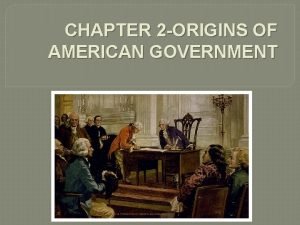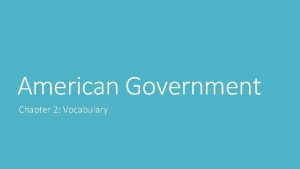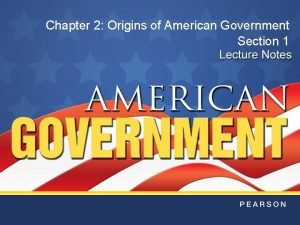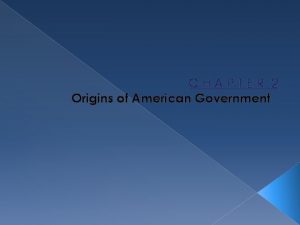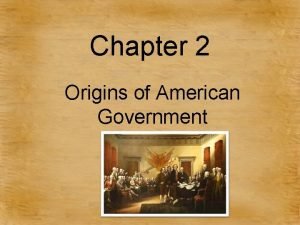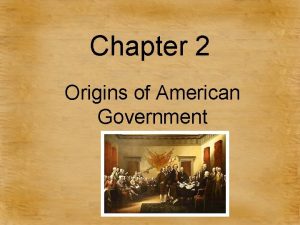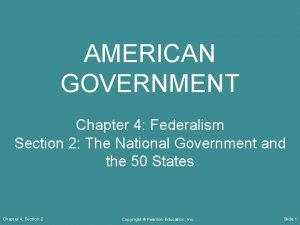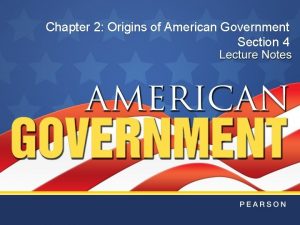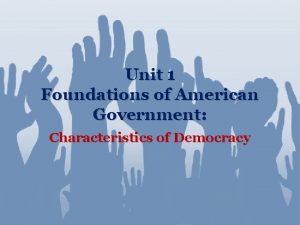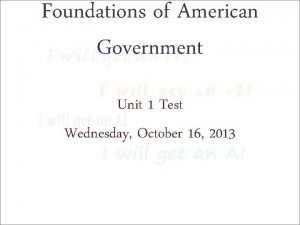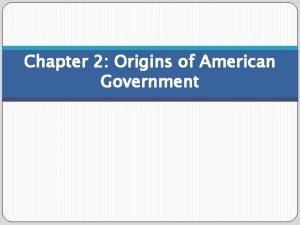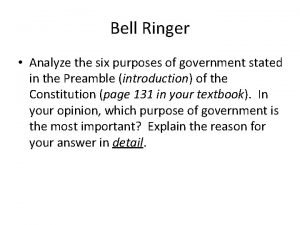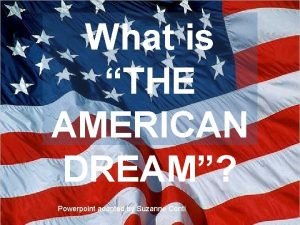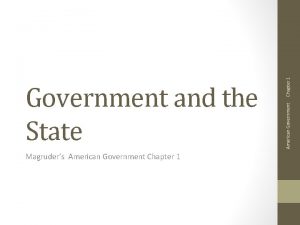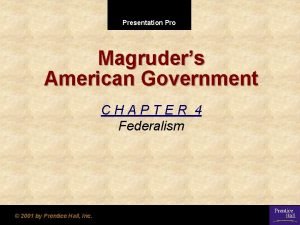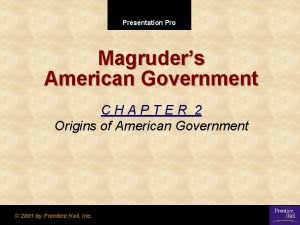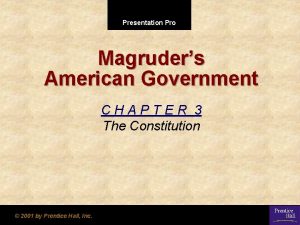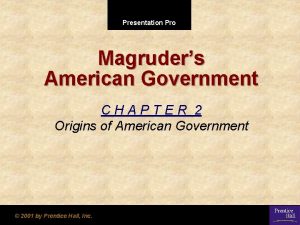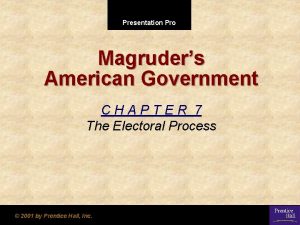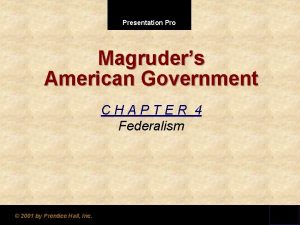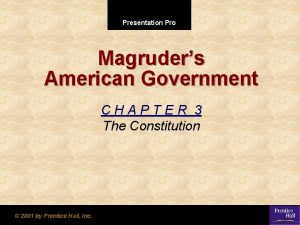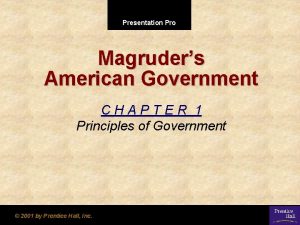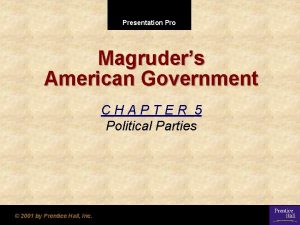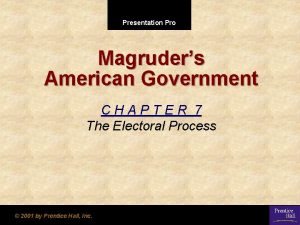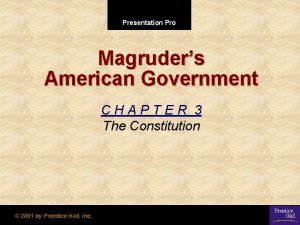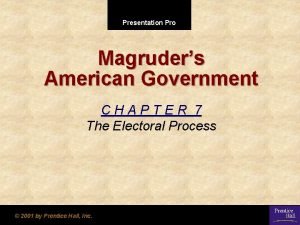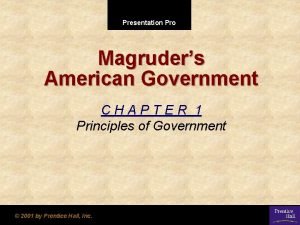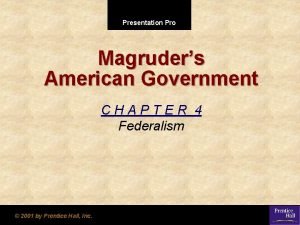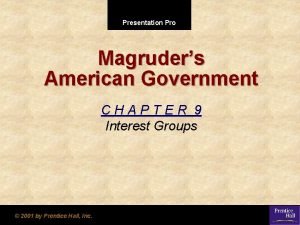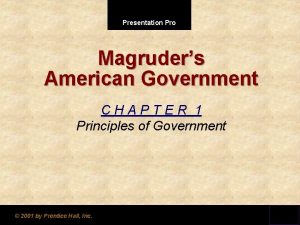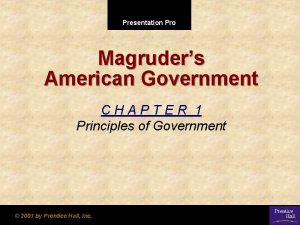Presentation Pro Magruders American Government CHAPTER 7 The











































- Slides: 43

Presentation Pro Magruder’s American Government CHAPTER 7 The Electoral Process © 2001 by Prentice Hall, Inc.

Standard 12. 6: Students evaluate issues regarding campaigns for national, state, and local elective offices. • In this chapter students will learn about all aspects of the electoral process – nominations, the role of the States, how votes are tallied, and the role that money plays in political campaigns. Go To Section: 1 2 3

CHAPTER 7 The Electoral Process SECTION 1 The Nominating Process SECTION 2 Elections SECTION 3 Money and Elections Go To Section: 1 2 3 Chapter 7

SECTION 1 The Nominating Process Objectives: 1. Explain why the nominating process is a critical first step in the election process. 2. Describe self-announcement, the caucus, and the convention nominating methods. 3. Discuss the direct primary the principal nominating method used in the United States today. 4. Explain why some candidates use the petition as a nominating device. Go To Section: 1 2 3 Chapter 7, Section 1

Vocabulary 1. Nomination 2. General election 3. Caucus 4. Direct primary 5. Closed primary 6. Open primary 7. Blanket primary 8. Runoff primary 9. Nonpartisan elections Go To Section: 1 2 3

A Critical First Step In the United States, the election process occurs in two steps: 1. Nomination, in which the field of candidates is narrowed 2. General election, where voters make the final choice of officeholder Go To Section: 1 2 3 Chapter 7, Section 1

Nominating and Electing a Candidate Go To Section: 1 2 3 Chapter 7, Section 1

Three Ways to Nominate • Self-Announcement – A person who wants to run for office announces their candidacy • The Caucus – Originally a private meeting of local bigwigs • The Convention – Considered more democratic than the caucus, convention delegates were selected to represent the people’s wishes Go To Section: 1 2 3

The Direct Primary Types of Direct Primaries Closed Primary Only declared party members can vote. Open Primary Runoff Primary Any qualified voter can take part. If a required majority is not met, the two people with the most votes run again Nonpartisan Primary Candidates are not identified by party labels Blanket Primary Qualified voters can vote for any candidate, regardless of party Go To Section: 1 2 3 Chapter 7, Section 1

Primaries Across the United States Go To Section: 1 2 3 Chapter 7, Section 1

Petition • Candidates must gather a required number of voters’ signatures to get on the ballot by means of petition. • Minor party and independent candidates are usually required by State law to be nominated by petition. • Petition is often used at the local level to nominate for school posts and municipal offices. Go To Section: 1 2 3 Chapter 7, Section 1

Section 1 Review 1. The most commonly used method of nomination today is (a) the caucus. (b) the direct primary. (c) self-announcement. (d) the convention. 2. A runoff primary is held in some States when (a) no one wins a majority of votes. (b) there is only one candidate. (c) not enough voters turn out on election day. (d) a candidate asks for a recount. Want to connect to the Magruder’s link for this chapter? Click Here! Go To Section: 1 2 3 Chapter 7, Section 1

SECTION 1 Summary 1. Explain why the nominating process is a critical first step in the election process. 2. Describe self-announcement, the caucus, and the convention nominating methods. 3. Discuss the direct primary the principal nominating method used in the United States today. 4. Explain why some candidates use the petition as a nominating device. Go To Section: 1 2 3 Chapter 7, Section 1

SECTION 2 Elections: Objectives • Analyze how the administration of elections in the United States helps make democracy work. • Define the role of precincts and polling places in the election process. • Describe the various ways in which voters can cast their ballots. • Outline the role that voting machines and other innovations play in the election process. Go To Section: 1 2 3 Chapter 7, Section 2

Vocabulary Terms 1. Absentee voting 2. Early voting 3. Precinct 4. Polling Place 5. Coattail effect 6. ballot Go To Section: 1 2 3

The Administration of Elections are primarily regulated by State law, but there are some overreaching federal regulations. • Congress States Can set the time, place, and manner of congressional and presidential elections. • Determine the details of the election of State and local officials. -Tuesday after the first Monday in November -even-numbered year for congressional elections, -presidential election, the same day every fourth year. Go To Section: 1 2 3 Most States provide for -absentee voting Some States started to allow Early voting Chapter 7, Section 2

Precincts and Polling Places Precincts • A precinct is a voting district. • Precincts are the smallest geographic units used to carry out elections. • A precinct election board supervises the voting process in each precinct. Go To Section: 1 2 3 Polling Places • A polling place is where the voters who live in a precinct go to vote. • It is located in or near each precinct. Polling places are supposed to be located conveniently for voters. Chapter 7, Section 2

Precinct Election Officials • Precinct election officials are required to perform all of the duties that our state legislature has required by law. These duties include receiving the ballots and supplies, opening and closing the polls, overseeing the casting of the ballots during the time the polls are open, and any other duties required by law. At each voting precinct there will be at least four precinct election officials. Go To Section: 1 2 3

Casting the Ballot • History of the Ballot Voting was initially done orally. It was considered “manly” to speak out your vote without fear of reprisal. • Paper ballots began to be used in the mid-1800 s. -At first, people provided their own ballots. -Then, political machines began to take advantage of the flexibility of the process to intimidate, buy, or manufacture votes. • In the late 1800 s, ballot reforms cleaned up ballot fraud by supplying standardized, accurate ballots and mandating that voting be secret. Go To Section: 1 2 3 Chapter 7, Section 2

Office-Group and Party-Column Ballots Go To Section: 1 2 3 Chapter 7, Section 2

Voting Machines and Innovations • Electronic vote counting has been in use since the 1960 s. Punch-card ballots are often used to cast votes. • Vote-by-mail elections (recent). Go To Section: 1 2 3 Chapter 7, Section 2

Electronic voting (also known as e-voting) -electronic means of casting a vote and -electronic means of counting votes. • • • two main types of e-Voting; • could facilitate electoral fraud electronic voting machines located at polling stations remote e-Voting (e. g. voting from one's personal computer, mobile phone, television via the internet. Go To Section: 1 2 3

Section 2 Review 1. Elections are held on (a) the first Wednesday after Halloween. (b) the first Tuesday after the first Monday in November. (c) the second Thursday after the first Monday in March. (d) the first Monday in December. 2. The Office-Group Ballot encourages (a) voter fraud. (b) split-ticket voting. (c) voter dissatisfaction. (d) the Democratic Party. Want to connect to the Magruder’s link for this section? Click Here! Go To Section: 1 2 3 Chapter 7, Section 2

SECTION 2 Summary 1. How does the administration of elections in the United States make democracy work? 2. What role do precincts and polling places play in the election process? 3. In what ways can voters cast their ballots? 4. What role do voting machines and other innovations play in the election process? Go To Section: 1 2 3 Chapter 7, Section 2

• Ch. 7 • S E C T I O N 3 Money and Elections Go To Section: 1 2 3

SECTION 3 Objectives • Explain the issues raised by campaign spending. • Describe the various sources of campaign funding. • Examine federal laws that regulate campaign finance. • Outline the role of the Federal Election Commission has in enforcing campaign finance laws. • Describe hard money and soft money. • Identify loopholes that exist in today’s finance law. Go To Section: 1 2 3 Chapter 7, Section 3

VOCABULARY 1. Political Action Committee 2. Subsidy – a grant of money, usually from the gov. 3. Soft money 4. Hard money Go To Section: 1 2 3

• Money: key role in politics, & serious prob. to a dem. Gov. Go To Section: 1 2 3

Campaign Spending Go To Section: 1 2 3 Chapter 7, Section 3

Campaign Spending • Est. total cost of 2012 elec. - jump 7% f/ $5. 4 bil. 4 yrs ago, could reach $6 billion. • One factor that could change the bottom line: Spending by super PACs ( don't have to reveal donors) - have multiplied in wake of Sup. Crt ruling. • USA TODAY Go To Section: 1 2 3 Chapter 7, Section 3

Campaign Spending Go To Section: 1 2 3 Chapter 7, Section 3

Sources of Funding Private and Public Sources of Campaign Money Small contributors Nonparty groups such as PACs Wealthy supporters Temporary fund-raising organizations Candidates Government subsidies Go To Section: 1 2 3 Chapter 7, Section 3

Regulating Campaign Financing • Early campaign regulations were created in 1907, but feebly enforced. • The Federal Election Campaign Act (FECA) of 1971 was passed to replaced the former, ineffective legislation. • . -(more stringent disclosure requirements ) • -(who & how much) Go To Section: 1 2 3 Chapter 7, Section 3

Regulating Campaign Financing • The FECA Amend. of 1974 were passed in response to the Watergate scandal -set limits on contributions -created the FEC – Federal elections commission Go To Section: 1 2 3

Regulating Campaign Financing • Buckley v. Valeo (1976) invalidated some of the measures in the FECA Amend. of 1974. -struck down sev. provisions incl. on the amt. of money a cand. c/d donate to own campaign Go To Section: 1 2 3

Regulating Campaign Financing • Also stipulated that the 1974 amend. on spending only apply to candidates who accept campaign money from the government, not those who raise money independently. Go To Section: 1 2 3

Federal Election Campaign Act • Contribution limits: Hard money: • money to a candidate • Limited at $1, 100 • Created a loophole: Soft money • Money given to political party • Unlimited Go To Section: 1 2 3

FECA Disclosure: must show who contributes NO Expenditure (spending) limit NO contributions from unions or corporations Go To Section: 1 2 3

PACs • Political Action Committees: fundraising arm of groups that can donate directly to a campaign Most are corporations • Contribution limit: $5000/year • Incumbents: pers. currently in office gets most of their $ Go To Section: 1 2 3

The Federal Election Commission (FEC) enforces: • the timely disclosure of campaign finance info. • limits on camp. contrib. • limits on camp. Expen. • provisions for publ. fund. of pres. Camp. Go To Section: 1 2 3 Chapter 7, Section 3

Loopholes in the Law “More loophole than law…” —Lyndon Johnson • Soft money—money given to State and local party org. for “party-building activities” that is filtered to presidential or congressional campaigns. $500 million was given to campaigns in this way in 2000. • Independent campaign spending—a person unrelated and unconnected to a cand. or party can spend as much $ as they want to benef. or work against cand. • Issue ads—take a stand on certain issues in order to criticize or support a certain candidate w/o actually mentioning that person’s name. Go To Section: 1 2 3 Chapter 7, Section 3

Section 3 Review 1. Sources of campaign funding include (a) nonparty groups, such as political action committees. (b) government subsidies. (c) candidates’ personal funds. (d) all of the above. 2. Under federal election legislature passed in the 1970 s, candidates are not allowed to (a) take government subsidies. (b) use their own money in campaigns. (c) take contributions of more than $1, 000. (d) all of the above. Want to connect to the Magruder’s link for this section? Click Here! Go To Section: 1 2 3 Chapter 7, Section 3

SECTION 3 Money and Elections / Summary 1. What are the issues raised by campaign spending? 2. What are the various sources of campaign funding? 3. How do federal laws regulate campaign finance? 4. What role does the Federal Election Commission have in enforcing campaign finance laws? 5. What loopholes exist in today’s campaign finance laws? Go To Section: 1 2 3 Chapter 7, Section 3
 Magruders
Magruders Chapter 2 american government
Chapter 2 american government Chapter 2 origins of american government vocabulary
Chapter 2 origins of american government vocabulary Chapter 2 origins of american government answer key
Chapter 2 origins of american government answer key Chapter 2 origins of american government worksheet answers
Chapter 2 origins of american government worksheet answers Chapter 2 lesson 1 government in colonial america answers
Chapter 2 lesson 1 government in colonial america answers Chapter 2 origins of american government
Chapter 2 origins of american government American government chapter 4
American government chapter 4 The macro pro pro maxcharltonmacrumors
The macro pro pro maxcharltonmacrumors State and federal constitutions
State and federal constitutions Origins of american government section 4
Origins of american government section 4 Ap government and politics unit 1 study guide
Ap government and politics unit 1 study guide Unit 1 foundations of american government
Unit 1 foundations of american government Origins of american government section 1
Origins of american government section 1 Foundations of american government unit 1 test review
Foundations of american government unit 1 test review Origins of american government section 1
Origins of american government section 1 What are the 6 purposes of government
What are the 6 purposes of government American dream powerpoint presentation
American dream powerpoint presentation Hát kết hợp bộ gõ cơ thể
Hát kết hợp bộ gõ cơ thể Lp html
Lp html Bổ thể
Bổ thể Tỉ lệ cơ thể trẻ em
Tỉ lệ cơ thể trẻ em Chó sói
Chó sói Chụp phim tư thế worms-breton
Chụp phim tư thế worms-breton Hát lên người ơi
Hát lên người ơi Các môn thể thao bắt đầu bằng tiếng đua
Các môn thể thao bắt đầu bằng tiếng đua Thế nào là hệ số cao nhất
Thế nào là hệ số cao nhất Các châu lục và đại dương trên thế giới
Các châu lục và đại dương trên thế giới Công thức tiính động năng
Công thức tiính động năng Trời xanh đây là của chúng ta thể thơ
Trời xanh đây là của chúng ta thể thơ Mật thư tọa độ 5x5
Mật thư tọa độ 5x5 Phép trừ bù
Phép trừ bù Phản ứng thế ankan
Phản ứng thế ankan Các châu lục và đại dương trên thế giới
Các châu lục và đại dương trên thế giới Thơ thất ngôn tứ tuyệt đường luật
Thơ thất ngôn tứ tuyệt đường luật Quá trình desamine hóa có thể tạo ra
Quá trình desamine hóa có thể tạo ra Một số thể thơ truyền thống
Một số thể thơ truyền thống Cái miệng xinh xinh thế chỉ nói điều hay thôi
Cái miệng xinh xinh thế chỉ nói điều hay thôi Vẽ hình chiếu vuông góc của vật thể sau
Vẽ hình chiếu vuông góc của vật thể sau Biện pháp chống mỏi cơ
Biện pháp chống mỏi cơ đặc điểm cơ thể của người tối cổ
đặc điểm cơ thể của người tối cổ Thế nào là giọng cùng tên
Thế nào là giọng cùng tên Vẽ hình chiếu đứng bằng cạnh của vật thể
Vẽ hình chiếu đứng bằng cạnh của vật thể Tia chieu sa te
Tia chieu sa te

